Africa’s animal kingdom is as spectacular as it is diverse. Its wide range of habitats plays host to some peculiar creatures, both big and small. In this article, we’ll find out more about 10 of the scariest reptiles you can find in Africa.
It’s worth noting that some of the species listed may be present in additional countries, parks, and national reserves not mentioned below.
1. Nile Crocodile
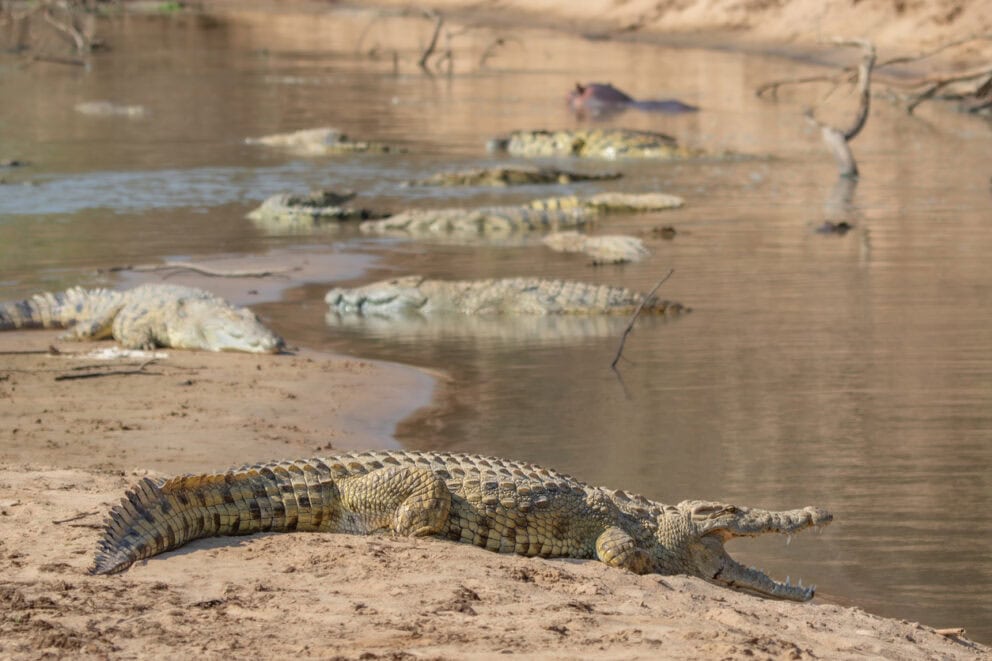
The Nile Crocodile is the largest freshwater predator in Africa and has the strongest bite in the animal kingdom, far more powerful than even the Great White shark. It’s probably also the most feared predator in Africa. Large crocodiles are known to swallow stones, known as gastroliths, to act as ballast, helping the crocodile balance its body underwater. The Nile crocodile is the most vocal of all reptiles, with up to five distinct calls. Places you’ll find the Nile crocodile include, but are not limited to:
- Kruger National Park (South Africa)
- Chobe National Park (Botswana)
- Bwabwata National Park (Namibia)
- Lower Zambezi National Park (Zambia)
- South Luangwa National Park (Zambia)
2. Puff Adder
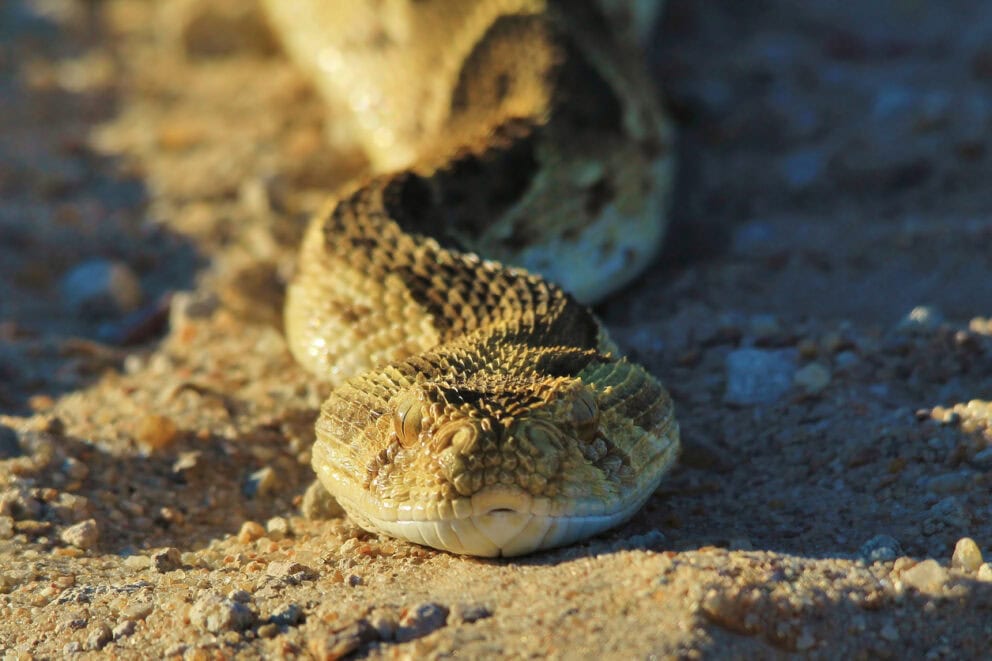
The puff adder is a very thick, medium-sized snake, measuring an average of about three feet long. Its subdued colors of tan, brown, gold, and even gray help it blend in with its environment. The puff adder gets its name from its ability to puff itself up when threatened. As a member of the viper family, it is defined by long, hinged fangs that penetrate deep into the skin and inject a highly toxic venom. Because of their wide distribution and tendency to bask on footpaths, they’re thought to be responsible for the most snakebite fatalities in Africa. Places you’ll find the puff adder include, but are not limited to:
- Tsavo East National Park (Kenya)
- Addo Elephant National Park (South Africa)
- Bwindi Impenetrable National Park (Uganda)
- Maasai Mara (Kenya)
- Serengeti National Park (Tanzania)
3. Black Mamba
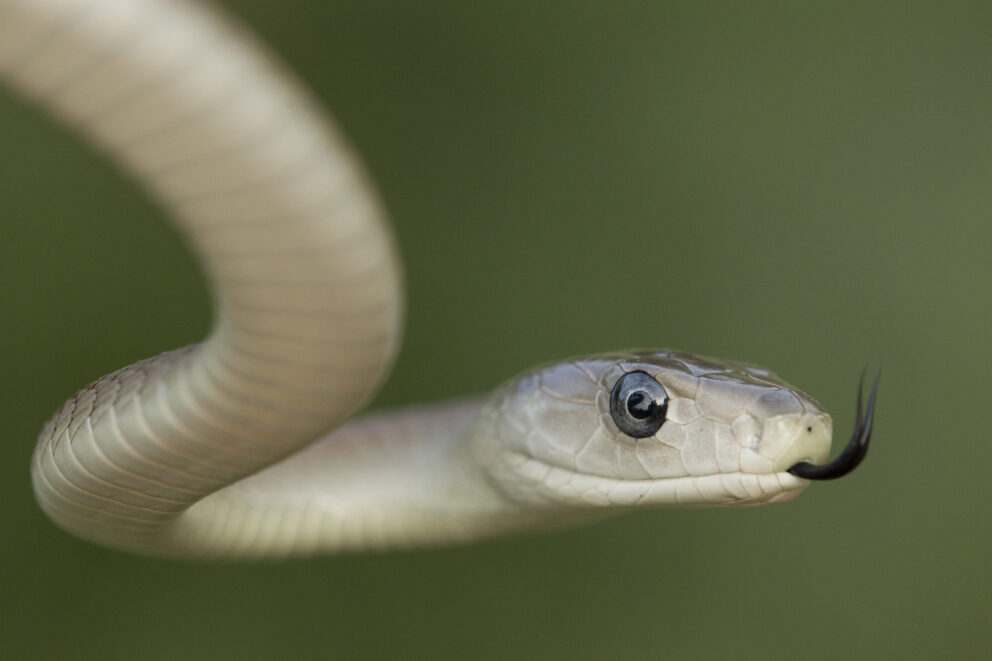
Although it has an aggressive reputation, the black mamba is generally shy and nervous, and will use its incredible speed (up to 12 mph) to escape threats. Despite its name, this snake is not actually black, but rather ranges from gray to dark brown, with a lighter underside. Once a black mamba attacks, it will bite its victim repeatedly. Its extremely toxic venom, two drops of which can kill a human, attacks both the nervous system and the heart. If disturbed or cornered, the black mamba will rear up and threaten with an open mouth and a slightly flattened hood before striking. Places you’ll find the black mamba include, but are not limited to:
- Hluhluwe-Imfolozi Park (South Africa)
- Selous Game Reserve (Tanzania)
- Queen Elizabeth National Park (Uganda)
- Tarangire National Park (Tanzania)
- Moremi Game Reserve (Botswana)
4. East African Green Mamba
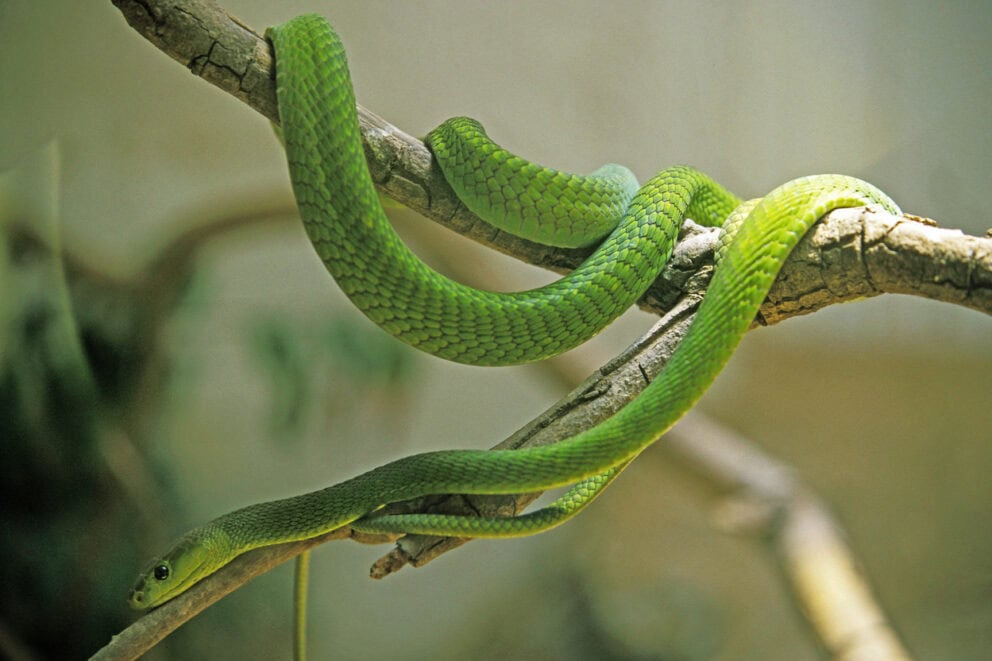
This snake prefers coastal areas with dense, shaded vegetation. It can be found living in trees in lowland tropical rainforests, coastal bushlands, and montane forests. These bright green mambas are opportunistic hunters and spend their days either stationary while waiting for prey to wander within their reach, or actively hunting small prey in the trees, such as birds and their eggs, lizards, and bats. These snakes are beautiful but highly venomous, with a neurotoxic venom that can lead to respiratory paralysis and death in as little as 30 minutes. Places you’ll find the East African green mamba include, but are not limited to:
- Tsavo East National Park (Kenya)
- Selous Game Reserve (Tanzania)
- Gorongosa National Park (Mozambique)
- Lake Malawi National Park (Malawi)
- Hwange National Park (Zimbabwe)
5. Boomslang
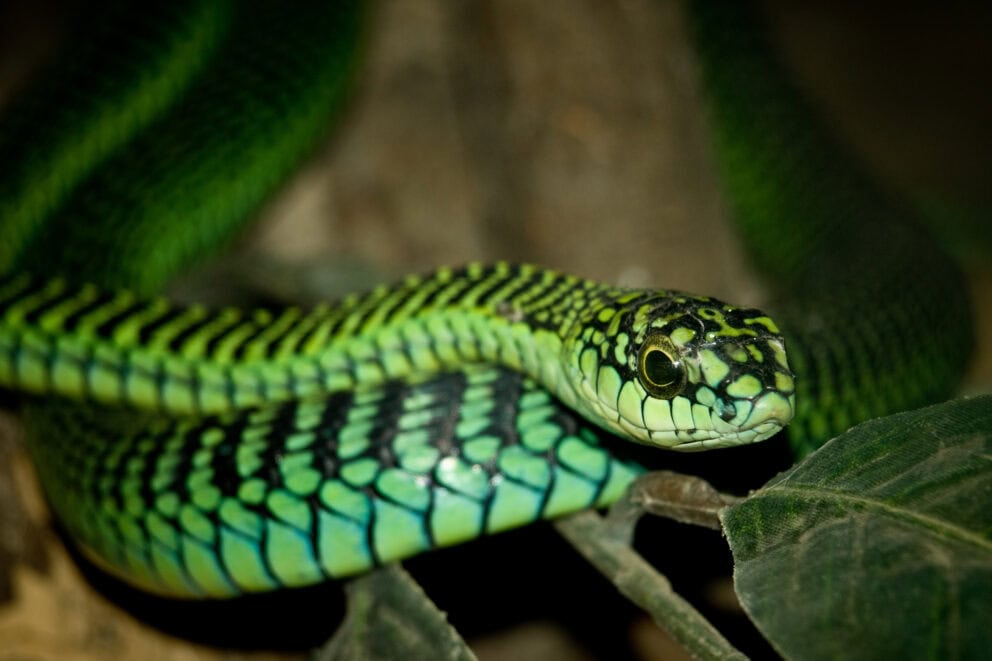
Boomslang is Afrikaans and Dutch for ‘tree snake’, and this is where these snakes will spend most of their time. The boomslang has a long, slender body measuring anywhere between three and six feet. These snakes have some of the most potent venoms among the entire group of rear-fanged snakes. When injected, the venom will attack the body’s circulatory system, and stop its ability to clot blood properly. Many victims will simply bleed to death, both internally and externally. Places you’ll find the boomslang include, but are not limited to:
- Bwindi Impenetrable National Park (Uganda)
- Moremi Game Reserve (Botswana)
- Lake Manyara National Park (Tanzania)
- Ngorongoro Conservation Area (Tanzania)
- Kidepo Valley National Park (Uganda)
6. African Rock Python
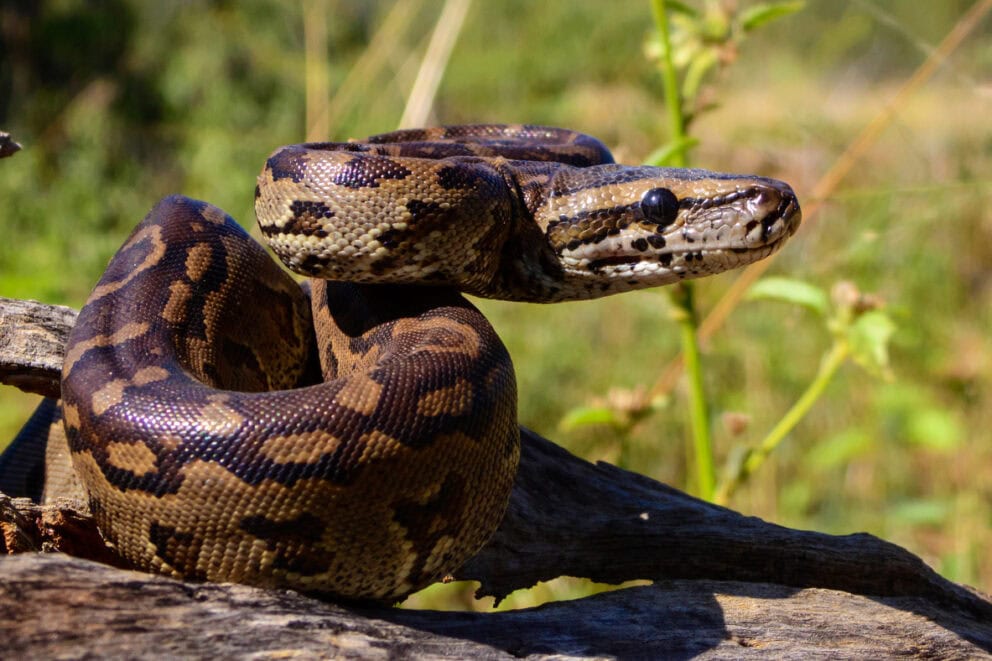
At 10-15 ft long, the African rock python is the largest snake in Africa. Like all pythons, this snake is non-venomous. Instead, it kills by constriction, ambushing and coiling around its prey, tightening its coils every time its victim breathes out. This eventually leads to death by cardiac arrest. African rock pythons feed on everything from birds to bats and medium-sized mammals. A larger python can capture warthogs, bushbucks, and even crocodiles. African rock pythons are often found near human settlements due to the presence of rodents and other vermin. They are excellent swimmers and can hold their breath for a long time. Places you’ll find the African rock python include, but are not limited to:
- Murchison Falls National Park (Uganda)
- Serengeti National Park (Tanzania)
- Virunga National Park (Democratic Republic of the Congo)
- Tsavo West National Park (Kenya)
- Garamba National Park (Democratic Republic of the Congo)
7. Cape Cobra
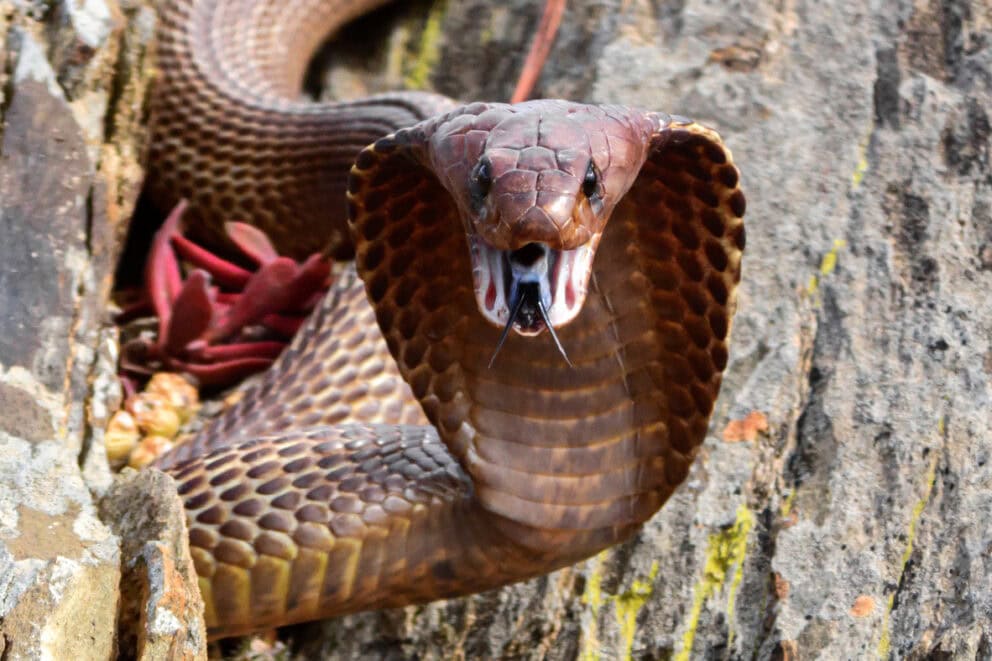
The Cape Cobra is one of four non-spitting cobras found in southern Africa. When disturbed, it will raise its head and extend its ribs to form a broad hood, accompanied by a loud hissing sound. Cape cobras have fixed front fangs which they use to bite their prey and inject a very powerful and fast acting neurotoxic venom, which can lead to paralysis and death. The Cape cobra is diurnal and actively hunts during the day. Its prey includes rodents, birds, frogs, lizards, and other snakes. Although found mostly on the ground, it’s able to climb into trees and shrubs to search for food or when confronted. Places you’ll find the Cape cobra include, but are not limited to:
- Kgalagadi Transfrontier Park (South Africa/Botswana)
- Namib-Naukluft National Park (Namibia)
- Pilanesberg National Park (South Africa)
- Marakele National Park (South Africa)
- Golden Gate Highlands National Park (South Africa)
8. Nile Monitor Lizard
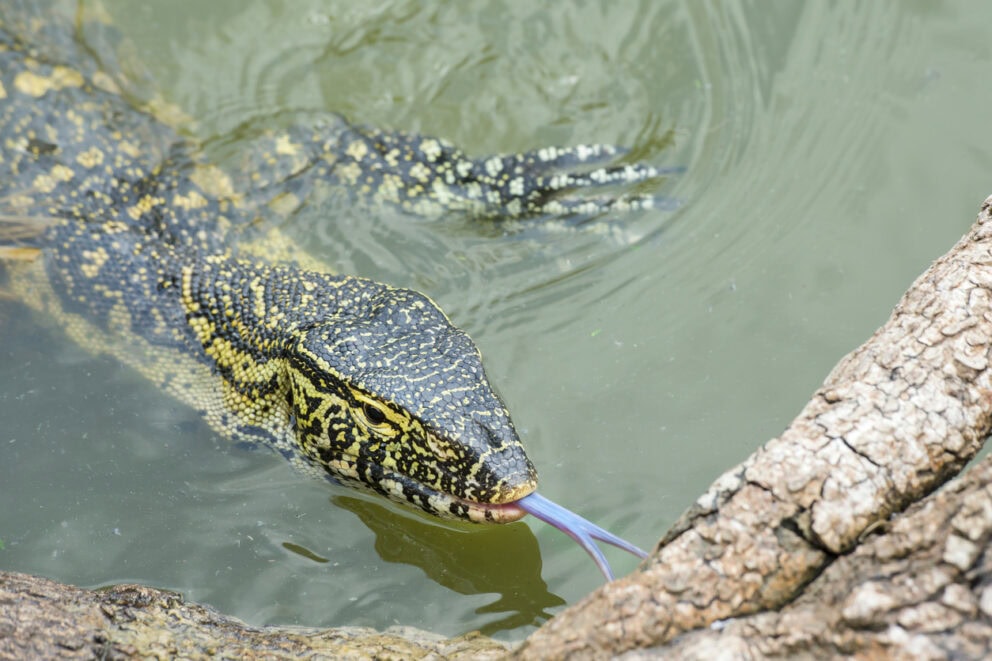
Also known as the water monitor, the Nile monitor lizard is the largest lizard in Africa. A versatile predator, it can climb, run, and swim with equal ease. Nile monitors have muscular bodies, strong legs, and powerful jaws. They also have sharp claws which they use for climbing, digging, defense, or tearing at their prey. They have forked tongues and possess highly developed olfactory properties. Nile monitors are highly aquatic and can stay underwater for up to 15 minutes. They feed on fish, snails, frogs, crocodile eggs and babies, birds, small mammals, insects, and carrion. Places you’ll find the Nile monitor lizard include, but are not limited to:
- Amboseli National Park (Kenya)
- Okavango Delta (Botswana)
- Ngorongoro Conservation Area (Tanzania)
- Ruaha National Park (Tanzania)
- Samburu National Reserve (Kenya)
Africa is home to a myriad of reptiles that are both captivating and fearsome. From the colossal Nile Crocodile with its formidable bite to the venomous Puff Adder and the swift Black Mamba, the continent boasts a diverse range of creatures that intrigue and terrify in equal measure. This exploration into Africa’s scariest reptiles offers a glimpse into the rich tapestry of wildlife that flourishes in its varied ecosystems. Book your safari today to see what kind of strange creatures you come across.






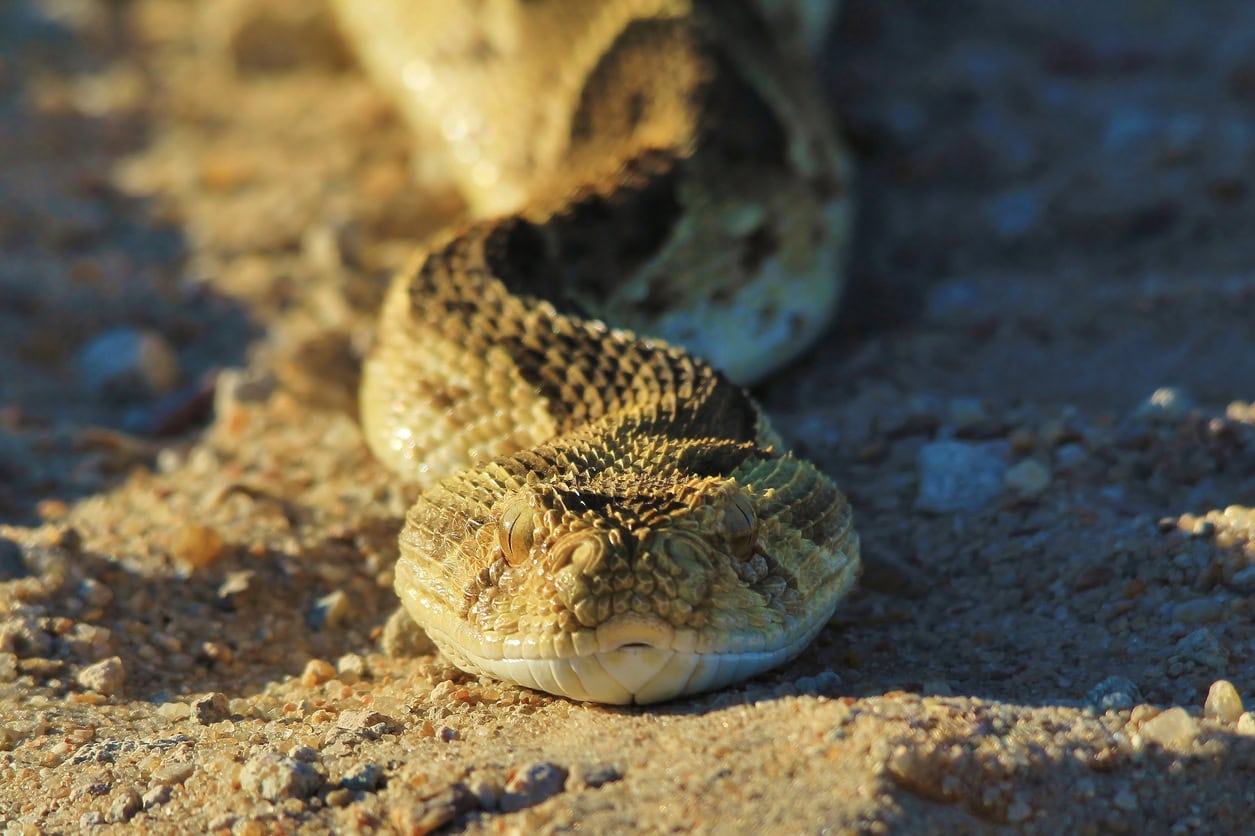


 Copy Link
Copy Link
 Share on LinkedIn
Share on LinkedIn
 Share on Facebook
Share on Facebook
 Blog List
Blog List









Written by Johnieka Holtzhausen
• Travel Writer
Verified by Adelle Bell
• Africa Safari Expert